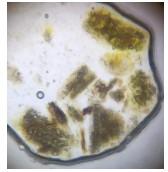
Submission to VIJ 2024-07-13
Keywords
- Curcuma zedoaria, rhizome characteristics, drying, simplicia
Copyright (c) 2024 Aptika Oktaviana Trisna Dewi, Ahmad Fatih Maulana Wakhid, Rafli Yusup, Annora Rizky Amalia

This work is licensed under a Creative Commons Attribution 4.0 International License.
Abstract
Curcuma zedoaria is one of the plants that has the potential to be developed as raw material for making traditional medicine. The results of the study showed that white ginger has diverse pharmacological activities such as antihyperglycemia, antihyperlipids, antihypercholesterol, antiviral, anticancer / antitumor, immunomodulators, analgetics, anti-inflammatory, antipyretic and antioxidants. In the production process of traditional medicines, the quality of simplicia used as raw materials must meet quality standards in order to provide a good therapeutic effect. The quality of white intersection simplicia can be influenced by several factors, one of which is the drying method. The purpose of this study was to determine the effect of drying method on the characteristics of white intersection simplicia. The drying methods studied are drying direct sunlight, greenhouse drying, wind and oven. The characteristics tested are organoleptis test, microscopic test, water soluble juice test, ethanol soluble juice, water content, total ash content, acid insoluble ash content, microbial and fungal contamination. The results showed that the drying method can affect the characteristics of Curcuma zedoaria simplicia. The greenhouse drying method produces simplicia with the highest levels of ethanol marine essence and watersoluble essence, respectively 10.97±0.013% and 13.86±0.110%. The lowest water content of simplicia using a 50oC oven is 5.48%. The lowest total ash content was with the hybrid method, namely 7.006±0.018%.
References
- S. Gharge, S. I. Hiremath, P. Kagawad, K. Jivaje, M. S. Palled, and S. S. Suryawanshi, “Curcuma zedoaria Rosc (Zingiberaceae): a review on its chemical, pharmacological and biological activities,” Futur. J. Pharm. Sci., vol. 7, no. 1, pp. 1–9, 2021, doi: 10.1186/s43094-021-00316-1.
- D. K. Poudel, P. K. Ojha, A. Rokaya, R. Satyal, and P. Satyal, “Analysis of Volatile Constituents in Curcuma Species, viz. C. aeruginosa , C. zedoaria , and C. longa , from Nepal,” pp. 1–12, 2022.
- L. Marliani, I. K. Sukmawati, D. Juanda, E. Anjani, and I. Anggraeni, “Penapisan Fitokimia, Kadar Kurkuminoid dan Aktivitas Antibakteri Temu Hitam (Curcuma aeruginosa (Christm) Roscoe.), Temu Putih (Curcuma zedoaria Roxb.) dan Temulawak (Curcuma xanthorrhiza Roxb.),” Herb-Medicine J., vol. 4, no. 1, p. 57, 2021, doi: 10.30595/hmj.v4i1.9092.
- N. Fahmi, I. Herdiana, and R. Rubiyanti, “PENGARUH METODE PENGERINGAN TERHADAP MUTU SIMPLISIA DAUN PULUTAN (Urena lobata L.),” Media Inf., vol. 15, no. 2, pp. 165–169, 2020, doi: 10.37160/bmi.v15i2.433.
- J. Zagórska, W. Kukula-Koch, M. Czop, K. Iłowiecka, and W. Koch, “Impact of Thermal Processing on the Composition of Curcuma longa Rhizome,” Foods, vol. 12, no. 16, 2023, doi: 10.3390/foods12163086.
- S. Y. Lee, V. Ferdinand, and L. F. Siow, “Effect of drying methods on yield , physicochemical properties , and total polyphenol content of chamomile extract powder,” no. November, pp. 1–8, 2022, doi: 10.3389/fphar.2022.1003209.
- W. N. H. W. Nasir et al., “Effects of different drying methods and solvents on biological activities of curcuma aeruginosa leaves extract,” Sains Malaysiana, vol. 50, no. 8, pp. 2207–2218, 2021, doi: 10.17576/jsm-2021-5008-06.
- K. F. Kalalagh, M. Mohebodini, R. Fattahi, A. B. Kashkooli, S. D. Dizaj, and F. Salehifar, “Drying temperatures affect the qualitative – quantitative variation of aromatic pro fi ling in Anethum graveolens L . ecotypes as an industrial – medicinal – vegetable plant,” no. May, 2023, doi: 10.3389/fpls.2023.1137840.
- A. Dewi, I. Syafiq, and M. Jelita, “Total Flavonoids of Patikan Kebo Extract ( Euphorbia hirta L . ) in Various Drying Methods,” vol. 12, no. 10, pp. 8–12, 2022.
- V. El Karim and I. Maesaroh, “STANDARISASI MUTU SIMPLISIA JAHE ( Zingiber officinale Roscoe)DENGAN PENGERINGAN SINAR MATAHARI DAN OVEN,” vol. 4, no. 1, pp. 1–10, 2022.
- A. Wijanarko, “Standardisasi simplisia daun ciplukan,” J. Farmasetis, vol. 9, no. 1, pp. 31–40, 2020.
- A. K. Sari, M. I. Rizki, L. Triyasmono, and G. Alfandani, “STANDARISASI PARAMETER SPESIFIK DAN NON SPESIFIK PADA SIMPLISIA KULIT BUAH MUNDAR ( Garcinia forbesii ) ASAL KALIMANTAN SELATAN STANDARDIZATION OF SPECIFIC AND NON-SPECIFIC PARAMETERS IN MUNDAR RIND ( Garcinia forbesii ) SIMPLICIA FROM SOUTH KALIMANTAN,” vol. 02, no. 01, pp. 56–72, 2023.
- R. I. Departemen Kesehatan, Farmakope Herbal Indonesia, II. Kementerian Kesehatan RI, 2017.
- D. Handayani, E. Halimatushadyah, and Krismayadi, “Standarisasi Mutu Simplisia Rimpang Kunyit dan Ekstrak Etanol Rimpang Kunyit (Curcuma longa Linn),” vol. 02, no. 01, pp. 43–59, 2023.
- M. Pandapotan Marpaung and A. Septiyani, “PENENTUAN PARAMETER SPESIFIK DAN NONSPESIFIK EKSTRAK KENTAL ETANOL BATANG AKAR KUNING (Fibraurea chloroleuca Miers),” Penentuan Param. … J. Pharmacopolium, vol. 3, no. 2, pp. 58–67, 2020.
- K. Masztalerz, P. Nowicka, and K. Lech, “The Effect of Nonthermal Pretreatment on the Drying Kinetics and Quality of Black Garlic,” molecules, vol. 28, no. 3, 2023, doi: https://doi.org/10.3390/molecules28030962.
- A. Calin-Sanchez et al., “Comparison of Traditional and Novel Drying Techniques and Its E ff ect on Quality of Fruits , Vegetables and Aromatic Herbs,” Foods, vol. 9, 2020.